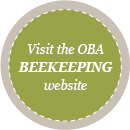The Honey Bee
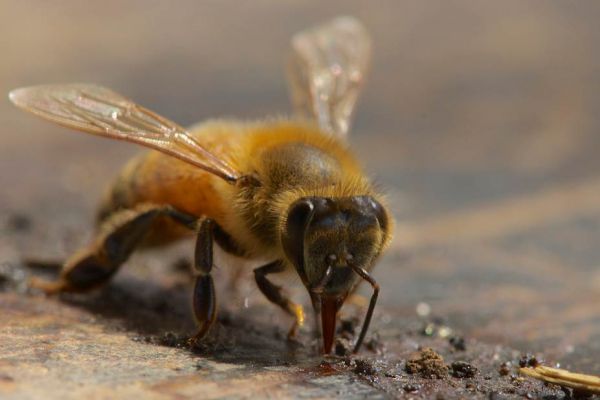
Originally compiled by Glen K. Hester
1. Introduction
Insects are by far the most numerous group of animals in the world. Butterflies are considered beautiful and wonderful to hold, but few people will pick up a Praying Mantis. Most of us consider insects ugly and pests, especially if they are found in our homes. Yet without them the world, as we know it would be a vastly different place. One third of the human diet is derived directly or indirectly from insect-pollinated plants. An estimated 80 percent of insect crop pollination is accomplished by honeybees.
When people think of bees they usually only think of one thing - the sting. Honeybees are herbivores and not aggressive creatures by nature. They only use their stinger if they feel threatened. Most people are stung by the more aggressive yellow jackets or wasps.
The study of the honeybee in the classroom will provide students with a fascinating look into the life of one of the "social insects". It will increase the students knowledge about the role of this insect in the ecosystem, and help to alleviate the unjustified fear which many people have towards them. It would also serve as a good introduction and preparation for a field trip to a commercially run apiary.
2. Background
Honeybees have been present on the Earth for millions of years. One of the oldest agricultural pursuits known to man is beekeeping. Early settlers to North America had a limited and expensive source of sugar, so honeybees were exported from Europe to establish apiaries here. The honey and beeswax gathered were used for many purposes. Today, many advances have been made in this aspect of agriculture. Some people derive their income from their apiaries while many others keep honeybees as a hobby.
3. The Beehive
Honeybees are called "social insects" because they live together in a society with adults and young sharing the same dwelling, and they exhibit a co-operative behaviour. No individual honeybee can survive on its own. They are all dependent on each other. Honeybees cannot be domesticated, but they are just as much at home in a man-made hive as they are in a hollow tree or cave.
Swarms often choose hollow cavities as nesting sites. Criteria for a nesting site include few and small entrances, shelter from the environment (i.e. wind, predators, sun and rain), and preferably a dry location with southern exposure. Inside the cavity, honey bees build their comb entirely out of beeswax secreted from the four sets of glands located in a worker bees abdomen. This wax is mixed with saliva and kneaded into the consistency at which it can best be molded. The comb is formed and shaped by the workers into hexagonal cells, set back-to-back.
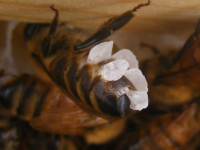
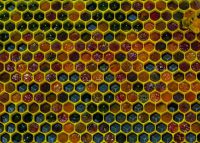
Beeswax Honeycomb
Unlike most other social insects, which build their cells hanging vertically, honey bees build their cells horizontally. The cells are angled up at about 130 from base to opening to keep the honey from running out. The vertically hanging combs are arranged in a parallel series and are placed a precise distance from the neighbouring comb. This distance, three eighths of an inch, is referred to as “bee space”. This space allows the bees to move between combs and to cluster to incubate the brood.
The cells constructed for rearing workers are smaller than those made to raise drones. Queens develop in long peanut shaped cells, which usually hang vertically from the comb.
The brood is located in the centre of the nest, where the temperature is most easily maintained. All cells are re-used, cleaned, and maintained by the workers after brood emergence, which are used for honey and pollen storage in addition to raising brood.
Beehives are constructed from a wide variety of materials throughout the world including mud, straw, and wooden boxes. In North America most beekeepers use a series of wooden box frames placed on top of each other to form a beehive. The major parts of a hive are shown in diagram one.
In order to take advantage of available nectar flows and turn it into honey, bees need to have enough space in the hive. If the colony does not have enough space to store surplus honey they may start to fill cells that were designated for brood production. When a colony has filled much of the brood chamber with honey stores and the queen is severely limited in space for egg laying, the colony is referred to as being “honey bound”. When a colony gets to this state, or often before they are completely honey bound, they are much more likely to swarm. The beekeepers’ responsibility is to recognize this and either split the hive to create two separate hives, adding a queen to the new hive or adding honey supers to give the bees more space to grow and create honey.
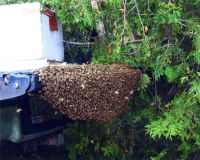
Bee swarm
DIAGRAM 1 - PARTS OF THE HIVE
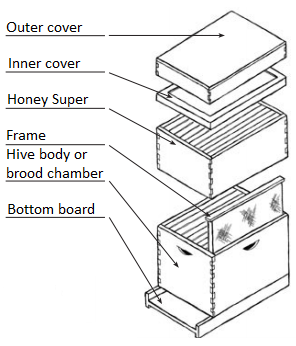
Table 1
Outer cover | Keeps rain and snow from entering the hive. It is usually covered with metal. |
Inner cover | Fits snugly over the top honey sugar to keep the honeybees in and everything else out |
Honey supers | Each super holds 9 or 10 frames of honeycomb. This is where extra honey is stored by the honeybees. As one super is filled with honey the beekeeper adds another one throughout the summer months. It is this honey which the beekeeper harvests. |
Queen excluder | A frame of metal bars wide enough for worker honeybees to pass through, but not the queen. This keeps the queen laying eggs in the brood chamber, not in the honey supers. |
Brood chambers | Brood chambers typically have 10 frames of honeycomb in which the queen lays her eggs. The eggs develop into adults here. This is the part of the hive where most of the honeybees are found, and the only place to find the queen. Some beekeepers use 2 brood chambers. Honey and pollen are stored here as food for the honeybees. |
Bottom board | Supports all of the boxes holding the bees and honey. It is the main entrance for the bees. |
Hive stand | Keeps the hive off of the ground to prevent the wood from rotting. |
4. Occupants of the Hive or Honey Bee Castes
The honey bee colony consists of three different castes: the female queen, female workers, and the male drones. Caste differentiation is determined genetically and nutritionally. Fertilized eggs develop into females, while unfertilized eggs develop into drones. Whether an egg is fertilized or not is determined by the queen when she lays the egg. A female egg will develop into a queen or worker depending on the amount and type of food that is fed to the larva. The queen is able to reproduce because she is given royal jelly, a secretion from mandibular glands on the heads of young workers, for an extended time.
THE QUEEN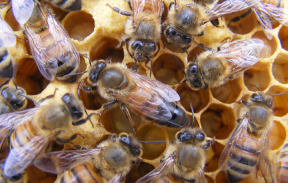
In most cases, there is only one queen per colony. The queen is the mother of all the honeybees in the hive and may live for up to five years. She can be recognized in the hive by her long narrow abdomen and short wings.
Before mating, the queen is referred to as a virgin. Virgins are intermediate in size between workers and mated, laying queens. They are difficult to spot while inspecting a frame, because virgin queens look similar to a large worker, They run across the comb, climbing over worker bees if necessary, and may even take flight if sufficiently disturbed.
She does not act as a ruler of the hive, but she is waited upon, fed, and protected by the worker honeybees. In order to become a fertile queen, a virgin queen must go on several "mating flights" during the first few weeks after hatching. Virgin queens mate with several drones and collect and store the sperm from each drone in a spermatheca. A queen will only mate with drones this one time in her life She will use the stored sperm to fertilize eggs to produce worker bees for the duration of her life.
She mates only once in her life and stores the sperm in a special organ, releasing some when she needs to fertilize an egg being laid. A queen lays on average between 1,000 and 1,500 eggs per day. Egg laying ceases when foraging is restricted, during a dearth and in the late fall. Sufficient egg laying informs the workers that the queen is functioning properly.
The queen is surrounded by young worker attendants, who lick her body for the pheromones that are needed for the well being of the colony. These pheromones stimulate feeding of the queen, inhibit the construction of queen cells, stimulate normal foraging behaviour, attract drones to mate with virgin queens, and inhibit the growth of worker ovaries. Queen pheromones are transmitted throughout the colony by physical contact between the bees.
The queen leaves the hive only for her mating flight. However, if the hive becomes too crowded early in the season, she may leave and take half of the honeybees with her. This swarm then searches for a new home. A new queen is left behind to make certain the old colony survives.
Watch the Video:
THE DRONES
Drones number from a few hundred to several thousand in a colony. These males are present in the spring and summer. These occupants of the hive are larger than the workers and can be recognized by a large, round, dark abdomen. Their main function in the hive is to mate with a virgin queen from a different colony. Mating takes place in flight. Drones do no work within the hive. They lack most of the work related structures associated with the female worker anatomy. For example, drones do not have a stinger. However, drones are equipped with large eyes to better see the flying virgin. Since their only duty is to mate with virgin queens in the spring and summer, they are evicted from the hive in the fall. The workers force the drones out of the hive to lower the population and conserve food supplies for themselves and the queen.
Therefore only the queen and workers survive the winter. Drones are not raised until the colony has enough resources to spare, and the production of drones will stop if environmental conditions worsen.
THE WORKERS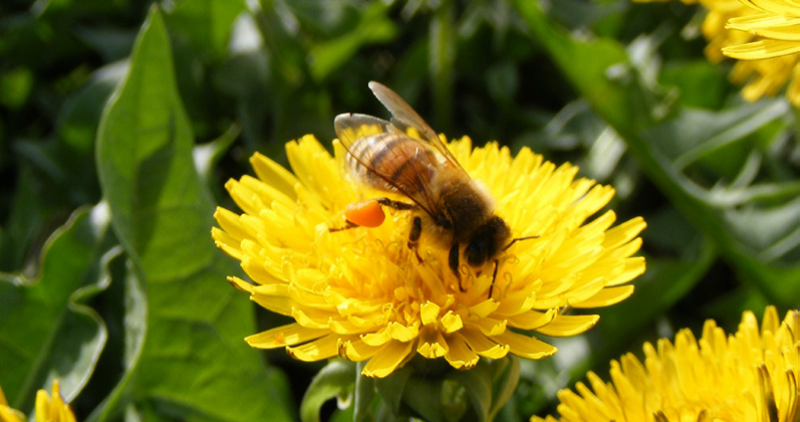
Most of the honeybees in the hive are female workers. Although these are female honeybees, they are infertile so no threat is posed to the queen's position in the hive hierarchy. They are the smallest inhabitants in the hive. A worker honeybee has a long list of responsibilities and duties to perform which change as she matures during her short 35-45 day summer lifespan. (See Table 2) Depending on the time of year, colony health and resources, a colony may contain from a few thousand up to 80,000 workers. A one or two day old worker begins her career as a brood (the baby larva) attendant by cleaning cells in which the queen will lay eggs and of newly emerged bees and sealing brood cells. Once three days old, she becomes a nurse bee by attending the larvae and the queen. House bees clean the comb, make honey, store pollen, feed and clean the queen and guard the hive against intruders. Hive cleaning and food handling comes next, the older worker bees perform tasks such as cleaning inside the hive, secreting wax to build cells, receiving and ripening nectar, packing pollen, fanning on the comb, and sealing honey cells. The last stage in a worker’s life involves outside jobs, such as ventilating, guarding, and foraging for materials, such as nectar, pollen, water, and propolis. The amount of time spent at each stage depends on the glandular development and maturation of the worker bee. It also depends on the number of workers in the colony and the needs of the colony. For example, if a number of foragers were killed by a crop spray, workers will mature at a higher rate. They would proceed through the succession of responsibilities faster to compensate for the lost foragers and maintain food resources. Likewise, the increase of resources in the colony may cause the queen to lay eggs at an accelerated rate. This would result in more workers functioning as cell attendants and nurse bees for a longer period of time, in order to attend to the increased brood production.
Workers live only for such a short period of time. They work so much in and out of the hive, that they literally wear out their wings and cannot return to the hive.
TABLE 2 - AGE AND RESPONSIBILITIES OF WORKER HONEYBEES
Age (days) | Responsibilities |
1-2 | Cleans cells and warms brood |
3-5 | Feeds older larvae |
6-11 | Feeds younger larvae |
12-17 | Hive repair, food transport within the hive, attend queen |
18-21 | Guard the hive entrance |
22-45 | Field bee collecting pollen, nectar and water |
5. Lifecycle
Although the inhabitants of the hive have different duties and physical characteristics they all pass through the same 4 stages of the lifecycle. The honeybee goes through complete metamorphosis. The timing of development depends on the caste.
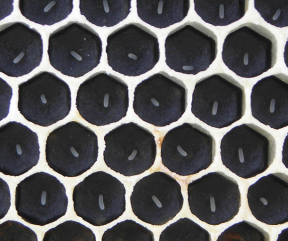
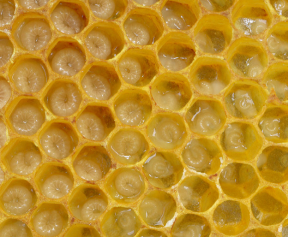
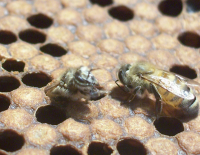
Eggs, larvae and an emerging bee
- Egg - The egg hatches after 3 days for all castes. In the egg stage, the genetic material of the queen and one of the many drones with whom she mated, are combined and develop into an embryo. The embryo will hatch into a larva, the second stage of the lifestyle.
- Larva - Most of the growing takes place during the larval phase, lasting 4-6 days. This is also known as the grub period in the honeybee's life. The tiny white semi-circle larva remains on the bottom of the cell develops and grows as it feeds on the secretions deposited by workers. After this, the workers cap over the cell and the larva stretches out then spins a cocoon.
- Pupa - The pre-pupal stage ends with a molt and results in the pupal stage. At this time the larva's cell is capped over to seal in the pupa. The pupa is the final stage during which the greatest amount of physical change occurs. Inside this cell the larva undergoes a metamorphosis and changes from an opaque, white larva into a mature black and yellow adult honeybee. The new adult chews away the cell cap and emerges to take her place in the hive population.
- Adult - The adult emerges on average after 16 days for queens, 21 days for workers, and 24 days for drones.
TABLE TWO - LIFECYCLE OF THE HONEYBEE (DAYS)
Stage | Egg | Larva | Pupa | Total |
Queen | 3 | 5 1/2 | 7 1/2 | 16 |
Worker | 3 | 6 | 12 | 21 |
Drone | 3 | 6 1/2 | 14 1/2 | 24 |
For more information on the honey bee life cycle
Watch the YouTube video: Honey Bees - Life cycle
6. Pollination
Honeybees need plants that produce flowers, and flowering plants need pollinators. The main value of honeybees to mankind, is in the cross-pollination of flowering plants and fruit blossoms. Most of our fruit and seed crops would not produce if it was not for the transfer of pollen from one blossom to another. About one-third of the total human diet is derived directly or indirectly from insect pollinated plants. The value of pollination to agriculture has been estimated to be far greater than the value of hive products. Honey bee activity supports several industries. The pollination of flowering crops would not occur without their foraging. Crops for animal stock or human consumption require it for food production and the propagation of their seeds for future plantings. Therefore, it is important for beekeepers and growers to understand pollination, seed and food production, and the importance of bees.
An estimated 80 percent of insect crop pollination is accomplished by the honeybee. Honeybees are highly specialized vegetarians, eating only nectar and pollen which are produced by flowering plants.
When a honeybee lands on a flower to collect the nectar it gets covered with pollen. The dust-like pollen clings to the hairs on the honeybee's body. When the honeybee visits the next flower the pollen on its body brushes off against the female part (pistil) of that flower. Pollination is the transfer of pollen from the anthers to the stigma of the same or another flower. When pollen is carried from one plant to another it is called cross-pollination. When insects gather pollen and nectar from flowers, plenty of pollen remains dusted on their bodies to be available for pollination.
Some plants have bright colored petals to attract honeybees, others produce scents to attract this pollinating insect. Plants which produce nectar secrete only small amounts at one time. This encourages many visits by many honeybees, which in turn increases the possibility that the plant will be successfully fertilized.
Many fruit tree farmers hire beekeepers to place hives of honeybees in their orchards during the blossoming season. They do this, to ensure that the flowers on their trees are pollinated properly, so that a healthy crop of fruit will be produced later in the growing season.
At the University of Guelph environmental biologists are experimenting with using honeybees to help control strawberry rot. A naturally occurring micro fungus will prevent the rot. A dispenser has been developed that fits on a beehive, so that emerging honeybees will inadvertently pick up and carry the spores of the biocontrol fungus. In the course of their flight the honeybees leave some of the spores on each flower, enough to prevent infection in the flower and fruit.
7. Honey Bee Nutrition
The diet of the adult honey bee consists of only two things: honey and pollen. Honey or nectar supplies the majority of the carbohydrate energy that workers need to perform daily activities. Pollen provides bees with all of their other nutritional requirements. Pollen includes proteins, fats, vitamins, and minerals. These dietary components are necessary for cell construction and metabolic processes. They are an essential part of the brood food that nursing workers feed to developing larvae.
Nectar
Nectar is collected from floral sources in the environment around the honey bee colony. This nectar can contain anywhere from 4 to 80% sugar and very little else. Most of the sugars in nectar are sucrose, glucose, and fructose. Collected nectar may be fed directly to developing larvae, but it is more commonly converted to honey first which can then be fed to larvae, or placed in combs for long-term and stable storage. When a forager brings nectar back to the colony, the worker regurgitates it into a cell. During this process, enzymes (most importantly, invertase) from the hypopharyngeal glands are added to the nectar. The enzymes convert the complex sugars in the nectar to simpler sugars that are easy to digest. Most of the sucrose gets converted to glucose and fructose. The nectar is “ripened” by other workers which lower the water content of the honey through evaporation until it is low enough to reduce yeast and bacterial activity.
Pollen
The importance of pollen to honey bee colonies is evident in the fact that it provides all of the rest of the nutrition (everything but sugars) that developing brood and adult honey bees need. It is also collected by foragers from plants and is carried back to the colony as small brightly coloured pollen pellets in the pollen baskets, area of long hairs on top of the forager’s hind legs.
Once the forager returns with the pollen, she removes the pellets by “kicking” them off into a cell that contains pollen left by other workers. The food handling workers (workers that are no longer nursing but have not yet begun foraging) process the pollen into bee bread. Bee bread is a mixture of pollen, honey and other constituents added by workers (not all of these are fully understood). These include acids which prevent the pollen from germinating and enzymes that help to prevent bacteria from destroying the nutritional value of the bee bread. As well, it appears that workers may add other beneficial bacteria which help to pre-digest the pollen so that workers can get more nutrients out of it when fully consumed. By processing the pollen into bee bread, the workers create a stable food that can be stored in a comb for a long time. Interestingly, bee bread is also relatively high in carbohydrates (up to 30-35% sugar).
Pollen is required by honey bees mainly for protein in order to develop normal physiological characteristics of honey bees and to maintain and grow a healthy colony. Without sufficient pollen quality and quantity, a colony can start to decline in population, production and become susceptible to diseases not normally considered severe to colony health.
Pollen must be consumed by workers so that they can achieve a normal physiology. As adults, workers typically start to nurse brood around 5 days of age. Before this can begin, they must develop the glands and organs that are involved in the production of brood food. Ingestion of large amounts of pollen is critical for the development of the hypopharyngeal gland, a large brood food-producing gland in the head.
Pollen availability affects a number of productivity aspects for the worker bees and the colony as a whole. A lack of pollen has been associated with a decrease in worker longevity, poor development of the hypopharyngeal glands and fat body, and a reduced ability to nurse or resist disease.
8. Honey Bees and Pesticides
How bees are poisoned
Modern agricultural methods use chemicals such as insecticides, herbicides, fungicides, and others for crop protection. Some of these chemicals are highly toxic to honey bees. Most honey bee poisonings occur when insecticides are applied to crops during their bloom period, or during the blooming period of other plants near the treated crops.
Apart from direct applications of pesticides to blooming plants, the hazard of bee poisoning can occur:
- when spray or dust pesticides drift in the air from adjacent crops
- if cover plants are incidentally sprayed (a problem in orchards)
- if pesticides remain as residues on plants which bees use
- if pesticides are collected instead of pollen (e.g. as dusts) by bees
- if bees drink or come into contact with water, nectar, or pollen contaminated with pesticides
Preventing bee poisonings
The most important part of preventing bee poisonings is co-operation between beekeepers, growers, and pesticide applicators. Uninformed growers and careless applicators who do not follow label directions can cause incidental bee poisonings. Beekeepers must also accept their responsibility of informing neighbors of the whereabouts and value of their bees. It is important for all parties to realize that pest control programs often can be modified to minimize their hazard to bees. Beekeepers and growers involved in pollination arrangements should be especially concerned about understanding the consequences of pesticide use.
The second important step in preventing bee poisonings is to know the pesticides and how to use them safely. Seed treatments are considered to have a low relative toxicity to bees primarily because it is unlikely that bees will encounter them. Talc and dust that combines with the seed treatments will become airborne and land on honey bee forage plants. It is important that these treatments are handled in a safe manner.
9. Communication
In order for the hive to operate efficiently, honeybees have developed a complex form of communication, which we do not yet fully understand.
In order to direct other worker honeybees to a source of nectar or pollen a returning worker uses a "dance language" within the darkness of the hive. The necessary information is communicated to the other workers in this dance. This saves the other field workers time and energy so that they can fly directly to the food source. The honeybees use the sun as a type of compass to indicate direction. They can sense the direction of the sun even on hazy days.
Honeybees do two basic types of dances: the "round" and the "waggle". If the food is up to ten metres away, the worker will do the round dance. If the food is more than one hundred metres, the worker will do the waggle dance. Between ten and one hundred metres the worker does a combination of the two dances.
THE ROUND DANCE
The returning worker does her dance on the vertical surface of the honeycomb. If the nectar is less than 100 metres from the hive she moves in a circle in one direction. Then she turns around and runs in another circle in the other direction. They can buzz around near the hive and quickly find the flowers. They know what kind of flowers to look for by the smell clinging to the body of the returning bee, and by tasting a sample of the nectar she shares with them.
THE WAGGLE DANCE
If the nectar is more than 100 metres from the hive, the returning worker does the waggle dance. This gives the other workers the direction and distance (flying time) to the food source. First she dances in a straight line rapidly wagging her tail. Then she turns and walks around a half circle, and dances back along the same straight line. Then she turns in the other direction and walks around the other half of the circle, and returns once more to her straight line. As she does this she wags her tail. The number of times the dance is repeated per minute tells how far the food is from the hive. A fast dance means the food is close to the hive, a slow dance means it is further away.
The straight line of the dance shows the direction to the nectar in relation to the sun. On the vertical honeycomb, a dance done straight up means fly away from the sun. If the dancer moves on a line to the left of straight up, that means, "Go to the entrance of the hive, look at the sun, and fly to the left". When the nectar is all gone, the returning workers do not dance, so that no more workers will go to that location.
10. Gathering the Honey
The apiarist collects the excess honey stored in the honey supers throughout the honey season. The brood chamber, where the queen and worker bees live, remains in place. It is the food stored in this part of the hive that will see the colony through the winter.
The frames which are full of honey are removed from the supers only when the beekeeper is ready to work with them. First he or she must remove the top cap seals from the honeycomb using a hot uncapping knife. Once this is done, the frame is placed in an extracting machine, which forces the honey from the honeycomb by centrifugal force. The honey runs down the side of the extractor and out a hole in the front, at the bottom of the machine.
11. Hive Products
Honey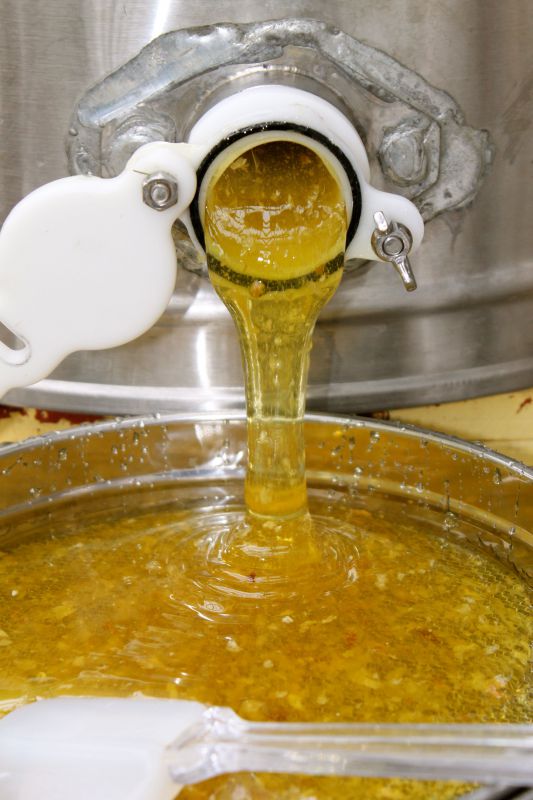
Honey is derived from nectar that is collected by honey bees from flowering plants. Each flowering plant or tree provides a unique nectar and flavour. The bees add enzymes and remove moisture to preserve the nectar as honey within the hive. Stored honey has a moisture level of approximately 17% and does not spoil.
The flavour, colour and the fragrance of honey depends upon the source of nectar. Clover produces honey with the lightest colour and mildest flavour. Buckwheat honey is the darkest in colour and strongest tasting.
The beekeeper benefits from knowing the source of the nectar for the collected honey and separate honey products are based on them and marketed accordingly.
When raw honey is extracted from the hive it is passed through a sieve to filter out any fine unwanted particles such as bee parts, pollen, wax and other impurities from the extraction process. This is raw honey; nothing has been added to it or removed from it. This can also be called unpasteurized honey.
Pasteurized honey
Pasteurization is the act of heating liquid honey 1450F-1700F (630C-770C) for 30 minutes.
Pasteurizing honey is very different from pasteurizing milk or other dairy products. Since honey has low moisture content and high acidity, bacteria and other harmful organisms cannot live or reproduce in honey. However, yeasts can live in honey. All nectar (the source for all honey) contains osmophilic yeasts, which can reproduce in higher-moisture content honey and cause fermentation. While fermented honey does not necessarily pose any health risk, pasteurizing honey should kill any latent yeast cells that might be present and possibly cause fermentation (if the moisture content of the honey is above 18%). If the extraction process is conducted accordingly, the moisture content of the extracted honey should be below this 18% moisture level, which means that the honey should never spoil.
Another aspect of pasteurizing honey is that it will slow down the granulation process. Pasteurized honey will last longer in its liquid state than unpasteurized honey, which makes it possible to remain appealing to the customer for a longer period of time while on the shelf in the store. Granulated or crystallized honey has not gone bad; the crystals simply have a less enjoyable texture than liquid honey.
Creamed Honey
Creamed honey is honey which has been granulated in a controlled fashion. It has a consistency of butter.
Comb Honey
Comb honey is often thought of as the “natural” form of honey. The pearl-white wax cappings seal in the original fragrance and flavour of the honey and give it aesthetic appeal.
Comb Honey Beeswax
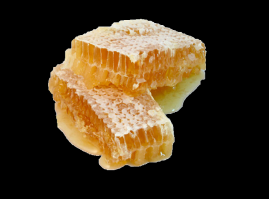
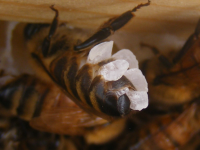
Beeswax
Wax is produced by 8 glands located between the overlapped portions of the last four visible abdominal segments on the underside of the worker bee. It is secreted in the form of small, irregularly shaped oval flakes or scales primarily during warm weather when foraging is active. Large amounts of honey and nectar are consumed during periods of wax secretion. For every pound of beeswax produced, the bees must consume 7 pounds of honey. To build a comb, the bee removes the wax scale from the gland and transfers it to her mandibles for mastication and the addition of a variety of enzymes from the bee’s saliva. The bee molds the pliable piece of wax into the comb of hexagonal cells or cell capping. Immediately after being secreted, beeswax is white and becomes darker with use inside the hive as pollen, silk and larval debris are inadvertently incorporated. Rendered, but untreated beeswax comes in varying shades of yellow.
Beeswax has a wide range of uses. Due to its plasticity and aroma, beeswax is used in the production of medicines, cosmetics and creams, lipstick, shaving cream, shoe and furniture polishes, candle making, chewing gum, crayons, aroma therapy creams, wax carvings, and waterproofing, to name a few.
Propolis
Propolis is the sticky tree resin that bees gather from trees buds or bark. Propolis is transported back to the hive in the bee’s pollen basket, where it is chiefly used as a ‘bee glue’ to seal and strengthen the hive. It has antimicrobial properties which control pathogens and limit contamination. This lining in the brood nest insures a clean environment for the rearing of brood.
Propolis has over 38 compounds called flavonoids (plant derived pigments and active compounds) that have anti-viral, anti-microbial, and anti-oxidizing properties. Propolis is used as an ingredient in natural supplements and herbal medicines. It is also used as an additive to skin lotions, beauty cream, mouth washes, shampoos, chewing gum, even lipsticks. A foam spray version of propolis is a popular treatment of sore throats, cuts, and skin rashes.
Pollen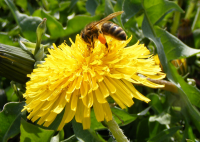
Pollen grains are collected by foraging honey bees in order to provide a nutritional protein source for the developing bees in the colony. Pollen is found on flowering buds of plants and trees and is collected directly or indirectly by the hair on the bee’s thorax. It is brought back to the hive attached to the bee’s pollen baskets.
Royal Jelly
Young workers secrete royal jelly from the hypopharyngeal glands and place it in queen cells as food for larval queens. It is the sole food of the queen larvae. Brood food (which is fed to workers and drones) is similar to royal jelly, but is modified through the addition of pollen and honey. Royal jelly has an opaque white colour, viscous texture, a pungent odour and a sour taste. The main markets for royal jelly include both the cosmetic and health food industries. The unique fatty acids of royal jelly cause it to be strongly antibacterial. There are accounts concerning the wound healing, skin cleansing and tissue repairing actions of royal jelly. In the health food market, royal jelly is often added to other products or used as a supplement which can be taken either as capsules, mixed in beverages, in confectionaries, or honey as a spread.
12. The Sting - Bee Venom
Honeybees are bred to be very gentle and will only sting to defend themselves, or the colony. More people are stung by wasps and yellow jackets than honeybees. If a honeybee lands on your arm, blow it off...don't hit it. Bee venom is synthesized in the venom gland of worker and queen bees. It is stored in the venom reservoir and injected through the sting apparatus during the sting process. The queen has a stinger which she only uses on other queens. Drones do not have stingers. A worker has a stinger which is barbed so that, once pushed into the victim, it cannot be pulled out. The whole stinger mechanism pulls out of the bee's body when she tries to withdraw it, so she dies shortly afterwards. A worker bee will die after using her stinger on a mammal, but will not die if used on another insect. The stinger and the venom pump are left behind and continue to inject poison into the victim. If you are stung by a honeybee, scrape the stinger away immediately with a fingernail. Do not try and pull the stinger out by squeezing it, as this will inject more of the venom into you.
A mature guard or foraging bee contains about 100 to 150g of venom and young queens contain 700g. Honey bee venom is a clear and colourless liquid. Upon contact with mucous membranes or eyes, it causes considerable burning and irritation. Beekeepers become accustomed to bee stings. The area around the sting will still swell on occasion but reactions are minimized. Venom is used to treat venom hypersensitivity, rheumatoid arthritis, and inflammation.
13. Infant Botulism
Botulism is caused by Clostridium botulinum, a spore that harbours in dirt and sometimes contaminates food. Most of the population can ingest these spores and not be affected by them. In cases where adults develop botulism, they do so by ingesting the active toxin, not the inactive spores. However, infants, under the age of one, do not have the level of acid to deter the spores of Clostridium botulinum from developing into the toxin, causing botulism. In rare cases, spores of Clostridium botulinum have been found in honey, so, as a precaution, Health Canada recommends that honey is not fed to infants under one year of age.


